AARON MARCUS
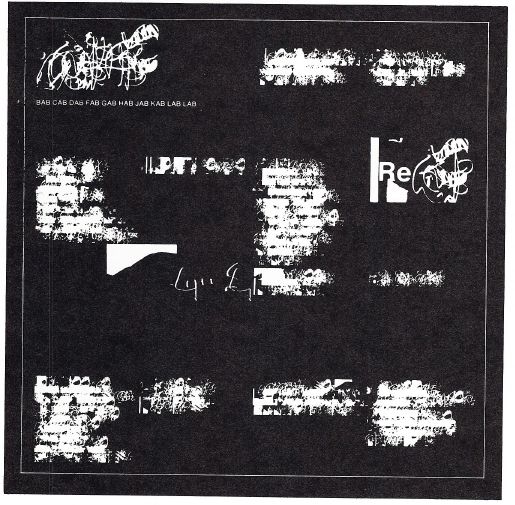
I became involved with computer graphics in 1967 by chance when I was a graphic design graduate student at Yale Art School following an undergraduate education in Physics at Princeton University. I worked for a summer at Bell Telephone Labs then and continued afterwards as a consultant in computer graphics for a number of years. My art background is a life long interest and activity plus graduate professional study at Yale Art School. I have been continuously working, teaching, writing, and studying in this area since then. The computer is a tool for a simulation and stimulation of realities. At times it can become a useful 'partner,' but only in limited ways. I do the essential conceptual work and all of the programming. My computer-assisted works are definitely related to non-computer art, both mine and others, especially work in conceptual art. When 'work' begins I have schematic notions and images. These are finalized as programming and viewing develop. Some of my work could be done without the assistance of a computer, but it would be very time-consuming and difficult. Others, like my conceptual environments (e.g. 'Cybernetic Landscape I,' 1971–3) must use computer graphics systems to be real-ized. I have the ability to do my own programming (Fortran, APL). Luckily, too, because I am not a millionaire and can not afford a fleet of programming slaves. Also, luckily, because I like to make and learn from my own mistakes. I think much computer art (so-called) of the sixties and even today is constipated, trivial dabbling or merely ornamentation (see my article 'Computer Art: Towards a Second Generation,' Print Review, No. 2, Pratt Graphic Center, New York, 1973). Nevertheless, I feel it will have a much greater impact in the future as terminal/display equipment falls into the hands of everyone—both the consumer/viewer and the artist. I plan to continue my work in computer graphics as an art form and recommend that it (computer graphics equipment and education) be made available to others, especially in art and design schools.
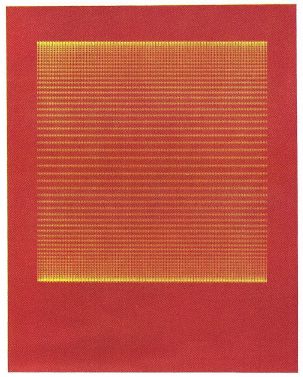
'Shades of Hades', lithograph; 5x6½ inches, 1972-4. Aaron Marcus
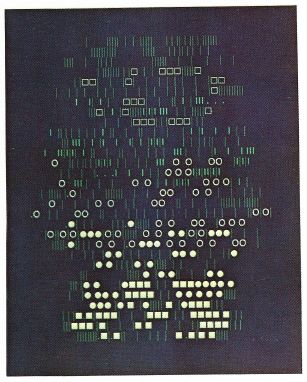
'Evolving Gravity', lithograph; 5x6½ inches, 1972-4. Aaron Marcus
Cybernetic Environments*
As writing was born, man struggled to find ways to compress his spatial, temporal, wraparound experience into abstract, easily reproducible marks on specially prepared flat surfaces. From essentially pictographic images bearing an iconic resemblance to things and actions, abstract forms evolved to provide man with more complex conceptions and a more intricately structured cosmos. After two millennia of relatively stable symbols and 500 years of their mechanical reproduction, the forms of writing, the ideas expressible by them are changing rapidly. At this moment, with the aid of electronic media and computer-assisted displays, the semiotic parameters of verbi-vocovisual communication are revitalizing long unused possibilities and discovering new combinations of elements for restating the inner and outer worlds of man's experience.
In the late nineteenth century, the poet Mallarme dreamed of a language and a language space in which everything could be expressive. With music as an ideal abstract formal system, he conceived of and began to make concrete a poetry in which marks, their form and position on a two-dimensional field, as well as their verbal denotations and connotations, contributed to a visual, spatial construction which one must see as well as read and hear. In the middle of this century, the international concrete poetry movement expanded and restructured the visions of 19th century innovators like Mallarme and Apollinaire. Joined to electronic, computer-assisted communication, the forms of visually oriented expression are beginning to bloom with a new array of ideas, a new dimension in abstract symbol communication and an all-encompassing environmental impact.
At the Computer Graphics Laboratory at Princeton University, I have developed a series of cybernetic landscapes utilizing programs in Fortran for a PDP-10 digital computer and an Evans and Southerland LDS-1 interactive computer graphics display system. The cathode ray tube device permits images in stereo and color as well as two-dimensional pictures which can be altered smoothly and instantaneously.

These landscapes in a simulated space provide a concrete, palpable, spatial experience of abstract visual forms and conventional verbal and typographic elements. As such, the space functions as a poem-drawing environment. Instead of the white field and black letterforms of traditional written symbols, the field is the deep, black space of night, and the symbols have been transformed into glowing filaments of light—a direct extension of the desire for 'constellations' which Mallarme, Gomringer and others cherished. The 'objects' are diagrams for objects, as the letterforms are diagrams for sound/ideas. All are in a dematerialized form. Computer graphics effectively interfaces with man via light. The images have no mass, no physical substance in a sense, but they are perceivable and meaningful to the viewer. Most importantly, the statements appear in a three-dimensional space. The viewer/reader/participant is no longer bound to the flat surface of the incised, written or printed sheet. By using the interactive equipment (a 'joystick' and knobs to control the display), the viewer may look at and wander through this aesthetically composed symbolic space at will.
The illustrations show various views of Cybernetic Landscape I. The small diagrams at the top indicate location of the viewer on the groundplane (dot in the square) and direction of view along the groundplane (line in the circle). Bars indicate height above the groundplane and a vertical viewing angle. The space is organized with hortatory slogans of the Consumptive Good Life distributed along a sacred axis. At certain locations, other visual elements are to be found in the space away from the main path, and the viewer may explore these as desired. The simple forms near the center of the space symbolize the 'I' of the viewer—the vertical presence moving about the horizontal landscape plane. In one quadrant of the space is a kinetic piece, a whirlwind of letterforms rotating silently with a pulsating, varying rhythm independent of the viewer's position or movement. Within the space is a diagrammatic 'person' who moves randomly along the groundplane. This creature is both a 'mirror' of the viewer and an indicator that other viewers, other human beings, could be connected to this space, could 'enter' it and could 'meet' the present viewer 'inside' this electronically created environment. The space is cyclically infinite. Each side wraps around electronically to the opposite side so the viewer moving off one edge would emerge instantly into the space again at the opposite edge. To signal the beginning/end of the journey, a canopy of points/stars/periods hovers in space at one terminus of the path.
By means of this computer-assisted display, new relationships—new meanings—emerge, depending on the position, movement, and viewing direction of the viewer/reader/participant. As objects of light, the elements in the space convey a distinct and forceful presence combining the mystery of dreams, the awesomeness of the starry night and the wonder of the modern, man-made urban environment seen at night. Instead of the strict topology of the stele, codex and later book forms, the linking of elements can be richer and more complex; yet is achieved through visually simple elements: points, lines and planes. These visual components of our familiar forms have been transmuted into light and space. The reader travels through the text as context.
Princeton, New Jersey
September 1975
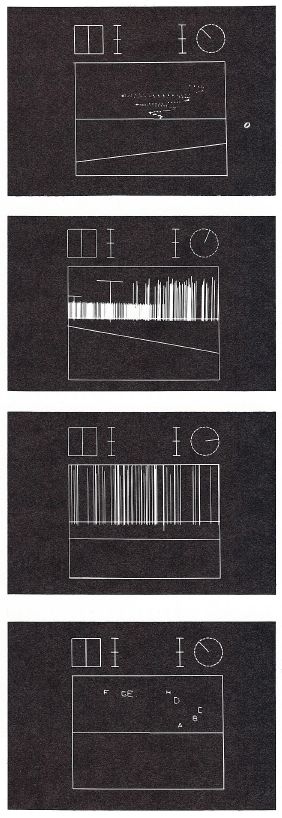
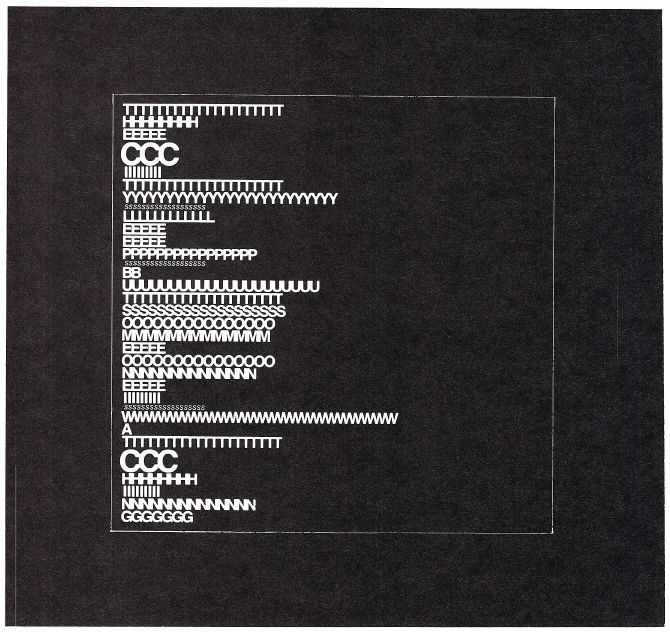
'The City Sleeps, but Someone is Watching', photoprint; 15x19 inches, 1972.

Photoprint, 1972
FOOTNOTE
* This article first appeared in the author's book, Soft Where Inc. It is reprinted by permission of the artist and WEST COAST POETRY REVIEW, 1127 Codel Way, Reno, Nevada, 89503 ©1975.
Return to Table of Contents | Previous Section | Next Section

